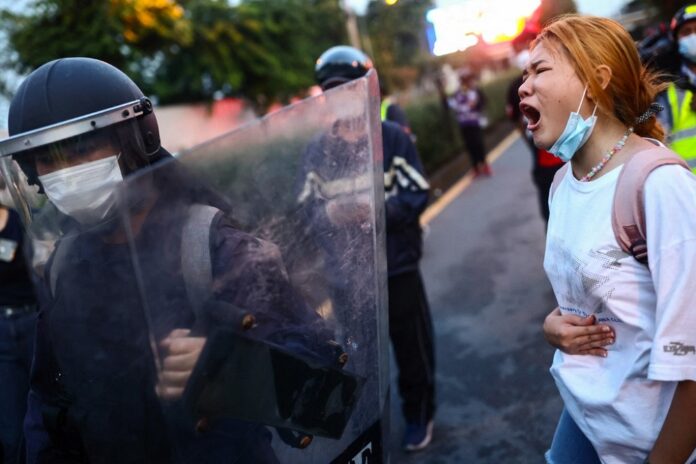An anti-government protester shouts at riot police during a demonstration in Bangkok September 28, 2021. — AFP pic
BANGKOK, Oct 26 — As night falls on a bustling junction close to the heart of Bangkok, gangs of young protesters take on police with slingshots, firecrackers and homemade “ping pong” bombs, turning the streets into a battle zone.
The student protest movement that gripped Thailand last year with its taboo-smashing demands for royal reform has largely died down, splintered by infighting and left rudderless by the arrest of several key leaders.
But since early August, a hard core of young working-class protesters calling themselves “Thalugaz” have fought near-nightly street battles with riot police armed with tear gas, rubber bullets and chemical-laced water cannon.
They organise through messaging apps and have taught themselves how to make small explosive charges or “ping pong bombs” using manuals found online.
“We gather at the intersection and move up the streets, throwing (ping pong) bombs and then they fire rubber bullets back,” 17-year-old protester Fhong told AFP.
Thalugaz, literally “breaking through (tear) gas” in Thai, is a loosely organised group of working-class youth in their teens and early 20s with no formal structure or strategy.
Their combative approach contrasts sharply with the gentler style of last year’s demonstrations led by university students who advocated change through speeches and political art performances, and adopted a cutesy rubber duck as their mascot.
The police’s handling of those largely peaceful rallies was criticised by some as heavy-handed, though they insist it was in line with the law and international standards.
But the Thalugaz protesters are determined not to go down without a fight.
“My friends and brothers got beaten to a pulp by who? The riot police,” 18-year-old Thom told AFP.
“If the riot police get hold of us, they’d kick and beat us, is that the right thing to do?”
Splintering
At their peak, last year’s protests drew tens of thousands onto the streets of Bangkok calling for the resignation of Prime Minister Prayut Chan-O-Cha, the former army chief who seized power in a coup in 2014.
They grabbed headlines with their demands for curbs on the power and wealth of King Maha Vajiralongkorn — unprecedented in a country where the monarchy, long revered, is protected by stringent lese majeste laws.
But the movement took a hit in early 2021 when leaders were arrested, new Covid rules limited gatherings, and splits emerged over tactics, ideology and demands.
Where last year’s protests focused on calls for constitutional change and high-level political reform, the Thalugaz youth are focused on economic and social demands.
“In a country where the gap between the rich and poor is so wide, (political) actions are different among different classes even if they share the same anti-government agenda,” political analyst Somjai Phagaphasvivat told AFP.
Many of the young protesters come from working-class families whose lives have been upended by the coronavirus, with street traders and small businesses forced to stop work in recent months because of strict lockdown measures.
“My aunt used to make 3,000 to 4,000 baht (US$90 to US$120) a day selling goods, but now her income has fallen to 1,000 to 2,000 baht,” Thom said.
He too was hit by the pandemic, when he had to shutter his auto repair shop in his native northeastern Surin province. Now he makes a living delivering ice around the capital.
As well as shouldering the economic burden of the crisis, poorer Thais living in cramped housing or slum dwellings have also suffered higher rates of coronavirus infection.
The virus has claimed more than 18,000 lives in Thailand and while the peak of the third wave has now passed, daily infection rates are still hovering around 10,000.
As such, it is hardly a coincidence that the main battleground for Thalugaz, Din Daeng, is a neighbourhood where low-income housing nestles among posh new apartment buildings close to the premier’s residence.
‘Payback’
Despite the unrest, there is some sympathy for the protesters among residents.
“The riot police are aggressive so the kids retaliate,” restaurant owner Sirirattana Siriwattanavuth, 32, told AFP.
“The protesters have obviously had enough, some of them are a bit radical and they want payback.”
But Manoon Houngkasem, a 67-year-old food vendor who has lived in Din Daeng for more than 40 years, said most residents are unhappy with the noise and violence.
It is not only protesters who have suffered injuries — police have been hurt too, including one officer shot in the head with a copper bullet.
With no sign of Prayut quitting and Thalugaz youths determined not to back down, residents of Din Daeng are facing more sleepless nights.
“If he does not resign, we will keep up this protest,” said Thom. “I will not give up.” — AFP



